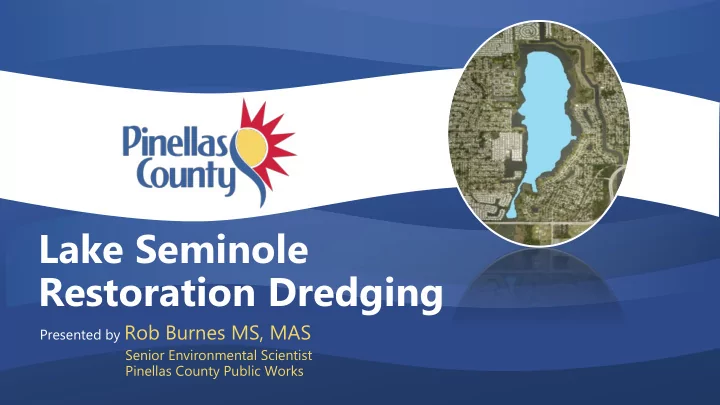

Lake Seminole Restoration Dredging Presented by Rob Burnes MS, MAS Senior Environmental Scientist Pinellas County Public Works
Background ▪ 684 acres ▪ 5.5 feet average depth ▪ Control structures regulate lake level ▪ Primarily used for recreation ▪ Fish community dominated by sunfish family ▪ Healthy emergent and submerged vegetation communities
Lake Seminole History- 1940’s ▪ Tidal estuarine system ▪ Mangroves ▪ Salt marshes ▪ Lake created in late- 1940’s ▪ Irrigation for orange groves ▪ Potable water source ▪ Impounded an arm of Long Bayou ▪ Flooded the system with freshwater from Long Creek
Lake Seminole History- 1950’s & 1960’s ▪ Rapid expansion in the area surrounding the lake ▪ Start of decline in ecological conditions ▪ Lake Seminole Park Constructed ▪ Current semi-circular weir installed in late 1960’s
Lake Seminole History- 1970’s & 1980’s ▪ Land use Switch ▪ 1976 Lake Seminole Bypass Canal created ▪ By the mid to late 1980’s ▪ Water quality was at an all-time low ▪ Nuisance vegetation at an all time high ▪ 1989 Pinellas BOCC passes resolution of long-term management plan
Lake Seminole History- 1990’s to Present ▪ Built out watershed ▪ Poor water quality ▪ Habitat loss ▪ Decline of sport fishery ▪ Harmful algal blooms ▪ Restoration efforts kick into high gear ▪ Watershed management plan finalized in 2001
Lake Seminole Restoration Efforts 1971- Elimination of direct input from wastewater plant 1987- Grass Carp introduced 1990’s - Stormwater pond rehabilitations 2001- Lake Seminole WMP 2002- Littoral shelf sediment removal and revegetation 2006- Lake draw-down and nuisance vegetation removal, replanting, and drainage improvements 2007- Lake Seminole Reasonable Assurance Plan adopted 2010’s - Construction of alum stormwater treatment systems
Reasonable Assurance Plan ▪ Developed in response to being an impaired waterbody pursuant to section 303(d) of the federal Clean Water Act ▪ Plan finalized in 2007, updated every 4 years ▪ Defined Structural, Management, Legal, and Policy Components
Organic Sediment Dredging ▪ Number one recommended project in Reasonable Assurance Plan ▪ Removal of 900,000 cubic yards of organic sediments ▪ Result in removal of ▪ 416 tons of TN ▪ 77 tons of TP ▪ Goal is to reduce lake’s internal nutrient loads
In-Lake Dredging Timeline ▪ Dredge Material Management Area (DMMA) construction started in January 2019 ▪ Active dredging to began in December 2019 ▪ Dredging to be completed by 2021
Hydraulic Dredging-How it Works ▪ Dredge barge moved into place by tender vessels ▪ Dredge template loaded onto barge GIS system ▪ Cutter head of barge will loosen muck and vacuum will suck up sediment
Hydraulic Dredging-How it Works ▪ Sediment then sent by pipe to upland dewatering site ▪ Slurry in the pipe approximately 5-8% solids ▪ Sediment and associate debris separated at upland site ▪ Clean sediment-free water returned to the lake
Dredge Material Management Area ▪ Area where dredged sediment will be placed. ▪ At the end of the project area will be capped with sand and sodded Example ▪ Pinellas County Parks will take over for use as recreational fields
Dredge Material Management Area ▪ 21 Acres at the top ▪ 50’ Deep ▪ Will contain approx. 800,000 CY during operation
Why this Approach ▪ Positive long-term environmental benefits (water quality, fisheries, beneficial habitats) ▪ Increases recreational opportunities ▪ Expanded youth sports in the unincorporated Seminole area ▪ Expand upland recreational opportunities ▪ Reduces traffic and impacts on schools and residents on 98 th St. ▪ Reduces project cost by nearly $20 million dollars
The Good News-Recent Water Quality ▪ Time series analysis shows significant decreasing trends ▪ Chl-a (Both Lobes) ▪ TP (Both Lobes) ▪ TN (Both Lobes) ▪ Turbidity (Both Lobes) ▪ TSS (Both Lobes)
Next Steps in Restoration ▪ Allow the DMMA site to settle and consolidate for at least one year prior to capping ▪ Continue monitoring ▪ Surface water ▪ Groundwater wells around the DMMA ▪ Groundwater seepage into the lake ▪ Plant trees to offset removal from DMMA site ▪ Wetland restoration near DMMA site
SWFWMD Project Video
For additional project information and updates: ▪ Visit the project website at www.pinellascounty.org/lake_Seminole_restoration.htm or www.pinellascounty.org/environment/watershed/watershed- lake-seminole.htm ▪ Contact the Project Manager Rob Burnes Public Works Environmental Management 22211 US Hwy 19 N Bldg 10, Clearwater, FL 33765 Phone (727) 453-3149 Email rburnes@pinellascounty.org
Special Thanks to our Funding Partners www.pinellascounty.org/publicworks
Recommend
More recommend